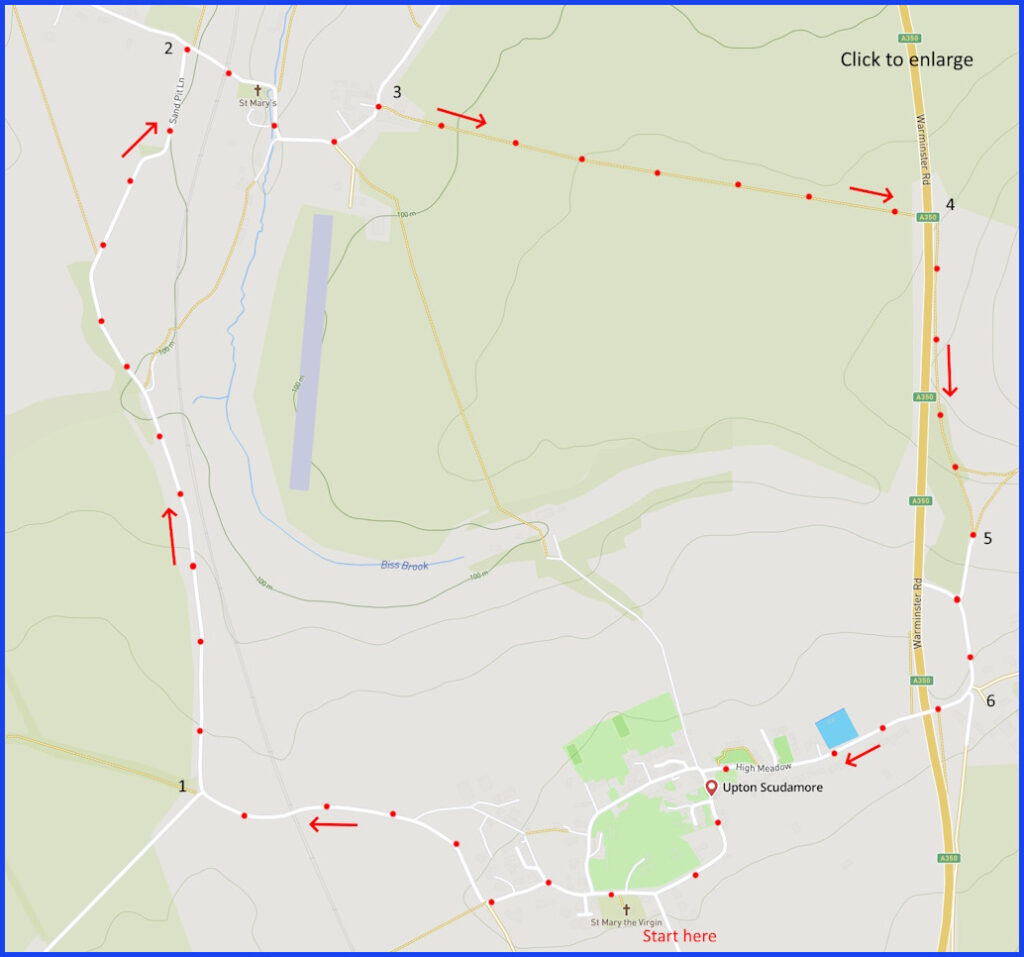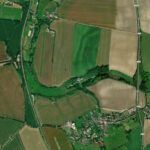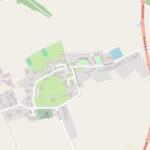A 3-mile, easy and charming walk. On lanes, open fieldpath and clear footpaths. Quiet at start – but still take care in case of occasional vehicle. Click here for an aerial view. Click here for a downloadable PDF of guide. (There is a GPX route option here for phone/tablet download. But only follow this link after watching this GPX help video). Friendly warning: all files relating to walks are published here in good faith but on the understanding that users must be responsible for their own safety and wellbeing.
(Routes suggested from each map point + metres to next point)
Start: Walk west away from church and follow road to …. [800m]
1: Turn right and follow road to … [1.3km]
2: At junction turn at sign for Old Dalton walk towards … [440m]
3: Walk between farm buildings to pick up field path and follow to … [950m]
4: Main road. Cross turn right onto a footpath parallel to road until … [520m]
5: Footpath becomes a lane. Forward until … [270m]
6: Right turn on road that leads back to suggested start [800m]
The pictures below are in the order things were seen on this walk. Clicking on any one will enlarge it (and the slideshow)
The Walk
This village is half way between Warminster and Westbury. You can get a sense of the area from this (rather long winded) drone video – although it does rather focus on the bypass you meet towards the end of this walk. The village is an ancient settlement: it features in the Domesday Book as Upton. Your walking starts at the parish church and then winds round a quiet country road towards the nearby hamlet of Old Dilton. From there you pick up a level and easy field track heading towards a hedgerow path. This leads you back into the other side of the village from that where you started. No cattle, stiles of other obstacles and very rare traffic on the initial lane (or in the village).
Upton Scudamore
The St Mary the Virgin church deserves a visit if it is open. The building is less ancient than perhaps it looks. There has been a church here since the 12th century. And for sure there are features that do date from that period (the font and the Norman doorway for example). But much of it was re-built in the Victorian era – to look 13th century in style. Although inside you may notice the effigies of two knights (possibly members of the Scudamore family) which certainly are 13th century.
However, what this church is better known for is its small single keyboard organ. This was designed in 1855 by the vicar, John Baron. He was anxious to support music in the church and although he had no knowledge of either music or instrument engineering, he worked with the village blacksmith to build what you see now. The project was very successful and more were made in the village (and subsequently in Warminster and then London). This design remains known as the Scudamore Organ.
There are several other matters of interest in the village. It is small but has a website and that will tell you a little more about the place. It is largely residential with a scattering of small businesses. Shortly after leaving the church area and from a sideroad to the left you may notice a little of this – including the pleasingly named: ‘girls who grind coffee’. The company declares “we are an independent, female founded, specialty coffee roasting and rebellion movement” while affirming that “bad bitches drink good coffee”. Shop at your own risk.
As you walk beyond that point you cross the railway and, shortly, the lane takes on a slight incline – particularly as you get closer to the railway line. This is modest walking for most pedestrians but the 1:75 ‘Scudamore Incline’ can still be a challenge for some trains on the Westbury Warminster main line.
Perhaps the most distinguished building in the village is Parks Court – which you pass on your right as you return to the village centre. This well-preserved country manor was held by the Parks (de Parco) family since 1242. It is now known as Avalon Manor – being available for homestays or hen parties (etc.)
Old Dilton
Old Dilton is tiny. It is an offspring of larger and nearby Dilton Marsh – site of Wiltshire’s least used railway station. While the settlement has largely been agricultural, there were once two fulling mills feeding from the River Bliss. Thus there would have been a thriving weaving industry in the immediate area – at least until the arrival of steam power and the migration of work to Westbury, Warminster and other nearby wool towns.
Anyone passing through this village should take a moment to look at St Mary’s church – which you walk past on this route. To get inside you will have to get a (large and traditional) key from a nearby house – but the effort is worth it. But if you have no time (or if the key is not available) then this video takes a long and lingering look at the building and its interior.
That video (like many published pictures of this church) is misleading for the artificial brightness typically imposed by photographers. The church is now “redundant” (i.e., no longer used for worship but maintained by the Churches Conservation Trust). However, one firm reason for protecting it has been its unusual, jumbled collection of internal furnishing typical of a Georgian era church – Pevsner says that, as an example of a pre-Victorian church interiors. it is “the best in the county”. You will see traditional gated box pews (facing both directions), including some of medieval origin. There is also a three decker pulpit, remnants of 15th century wall painting, and a small gallery that was once used a school room. Before, or later perhaps, you may care to look at this video tour, or these guided audio tours – to help make more sense of what you see.
Finally, on your return to Upton Scudamore you could well take advantage of refreshment at the old Angel Inn – its focal point is an Italian food menu.




![[A]](https://wiltshirewalks.com/wp-content/uploads/2023/11/uptonscudamore_01-150x150.jpg)
![[B]](https://wiltshirewalks.com/wp-content/uploads/2023/11/uptonscudamore_02-150x150.jpg)
![[C]](https://wiltshirewalks.com/wp-content/uploads/2023/11/uptonscudamore_03-150x150.jpg)
![[D]](https://wiltshirewalks.com/wp-content/uploads/2023/11/uptonscudamore_04-150x150.jpg)
![[E]](https://wiltshirewalks.com/wp-content/uploads/2023/11/uptonscudamore_05-150x150.jpeg)
![[F]](https://wiltshirewalks.com/wp-content/uploads/2023/11/uptonscudamore_06-150x150.jpg)
![[G]](https://wiltshirewalks.com/wp-content/uploads/2023/11/uptonscudamore_07-150x150.jpg)
![[H]](https://wiltshirewalks.com/wp-content/uploads/2023/11/uptonscudamore_08-150x150.jpg)
![[I]](https://wiltshirewalks.com/wp-content/uploads/2023/11/uptonscudamore_09-150x150.jpg)
![[J]](https://wiltshirewalks.com/wp-content/uploads/2023/11/uptonscudamore_10-150x150.jpg)